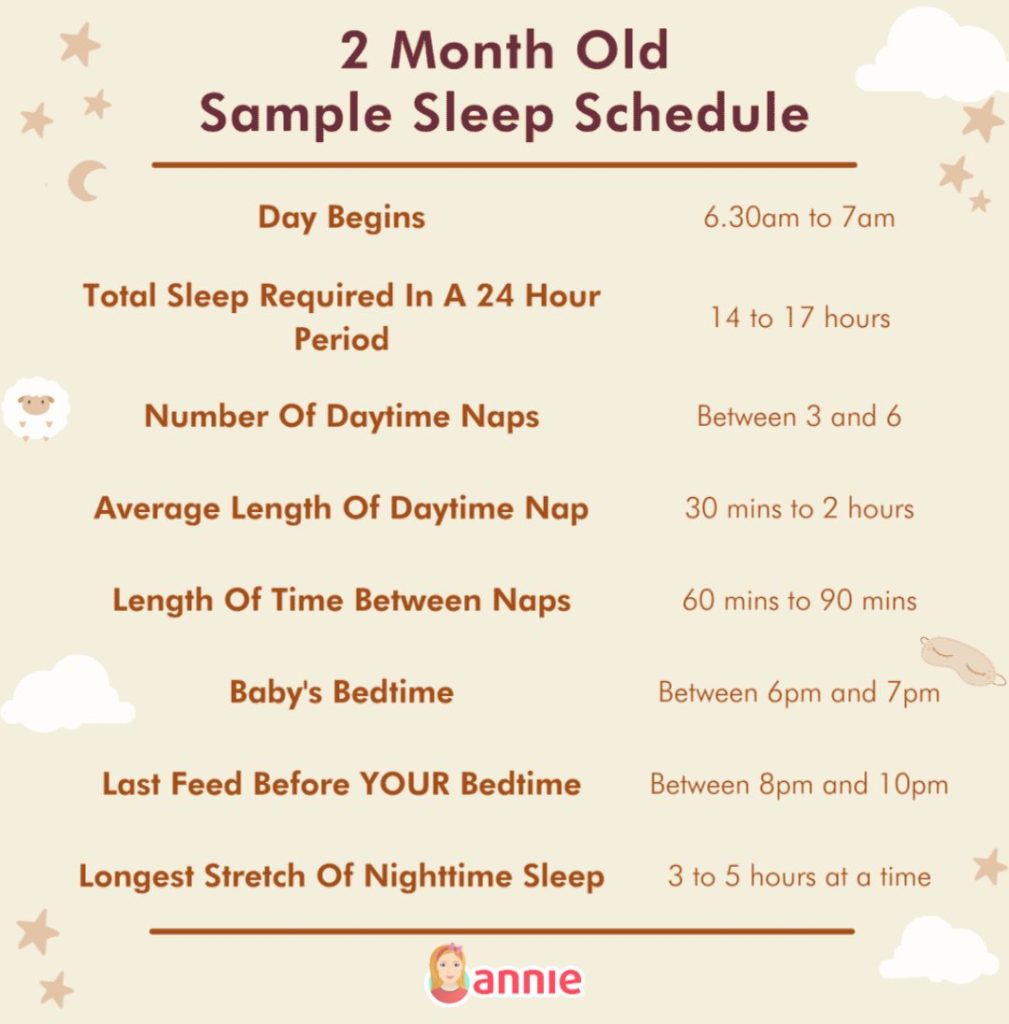
Navigating the 2-Month-Old Sleep Schedule: A Comprehensive Guide for Parents
- Created:
9. 11. 2023 - Updated:
9. 11. 2023
Get this:
By the second month, your newborn is already experiencing significant changes that require your attention. Everything, including their sleep, evolves to facilitate their growth.
As such:
Noticing nuances in their sleep and making necessary adjustments makes all the difference in the quality and quantity of rest your baby gets.
But how do you go about it?
Let’s take a deep dive into navigating and creating the 2-month-old sleep schedule. We’ll also highlight why it is important and how to identify sleep windows.
The Importance of Sleep for a 2-Month-Old
It’s known that newborns spend most of their time asleep. But while rest is good, what are the upsides of them sleeping so much?
Firstly:
A sleeping baby is a growing baby. When your baby sleeps, their body releases Somatotropin, a growth hormone, in large quantities.
Now:
Babies gain plenty of weight in their first months, and sleep is key to achieving that. Two-month-olds typically grow by about one and a half pounds and 1 inch every month, but inadequate rest stunts these.
Proof?
A study by Michelle Lampl and Michael L Johnson affirms a positive correlation between increased bursts of sleep and height spurts.
But there’s more:
Getting enough shut-eye helps them repair and regenerate tissues, allowing healthy growth. So, putting it together, plenty of sleep equals healthy growth and physical well-being.
Additionally:
How long your baby sleeps influences their mental capacity. Babies appear inactive apart from eating, crying, and being bundles of joy. But while they’re seemingly aloof, they’re learning.
And as you know:
All learning requires consolidation. This happens while they sleep. During this time, your baby’s brain processes information. Proper sleep encourages better memory retention, increased understanding, and general cognitive development.
So, now we know how important sleep is to your 2-month-old. But how much sleep do they need?
Babies of this age need about 14-16 hours of sleep daily. Thankfully, this number is an aggregate of all naps, both lengthy and staggered.
And here’s a tip:
Your baby doesn’t fall asleep at random times. They have sleep windows—periods when they can be easily put down to rest.
Luckily, that’s our focus for the next section.
Identifying Sleep Windows
News:
Getting your baby to sleep is easy with the right know-how. And the first step is identifying their sleep windows.
For context:
A sleep window is the optimal time for sleep. It is the period when your baby is naturally drowsy, easily falls and stays asleep.
Now:
Babies of this age, unlike adults, don’t have a fully developed circadian rhythm. Therefore, you must be adept at spotting their sleep windows to help them get rest.
So how do you do that?
There are a few signs that point to their sleep window. Let’s highlight some.
- Yawning: Babies yawn when they’re tired. If you catch them repeatedly yawning, then that’s a sleep window.
- Fussiness: Babies, like us, become irritable when they’re tired. During their sleep window, they may fuss and be more difficult to please.
- Eye Rubbing: Rubbing of eyes is often accompanied by yawns. It is a physical tell that their eyes are closing due to tiredness.
- Less activity: During their sleep window, your playful, active baby becomes less engaged with people and their surroundings. This indicates that their energy levels are down, and they need to recharge.
- Also, if your baby blinks more than usual, pulls at their ears, and has droopy eyelids, they are tired and need sleep.
Now:
If you cracked your baby’s sleep windows before now and had them adapted to a sleep schedule, that’s great. But remember that your baby’s sleep pattern changes as they grow. Thus, identifying their sleep windows is an iterative process.
You don’t want to be the reason your baby fights sleep.
Creating a 2-Month-Old Sleep Schedule
Fact:
Your baby’s sleep pattern is ever-changing. When they were newborns, you probably had a mental (or physical) note of when you’d put them in their crib.
But now:
That doesn’t seem to help anymore. This is because as their sleep needs, windows, and patterns have changed, their sleep schedule must change with them.
Thus:
Crafting a sleep schedule for a 2-month-old is necessary, and luckily for you, we have a step-by-step guide to creating one for your baby.
1. Observe Your Baby’s Natural Rhythms
News:
Your baby’s circadian rhythm is the natural body clock that regulates their sleep-wake cycles. The Natural Institute of General Medical Sciences further explains it as the mental, physical, and behavioral patterns that accompany our daily cycle.
And here’s a fact for you:
It is present in all humans, not just babies. However, ours is much more developed.
Now, how is this related to your baby’s sleep schedule?
Since your baby’s circadian rhythm describes its daily cycle, studying it helps you time their naps more accurately. The more aligned your baby’s sleep schedule is to its circadian rhythm, the longer and better they sleep.
Here’s a tip:
If you’re wondering how you’d remember the results of your observation, you should keep a sleep diary. In this, you can document details such as nap times, how long they take to fall asleep, and the possible number of interruptions. Doing this would make studying your baby’s natural patterns more successful.
So, get studying!
2. Establish a Bedtime Routine
Putting your baby down for sleep isn’t always easy. Do it wrong, and you may just have set yourself up for rounds of crying.
But there’s a simple solution:
To put your 2-month-old to bed on a regular basis, you must establish a bedtime routine. Create some activities just before bedtime to put your baby in a sleepy mood. Doing this consistently would make it a sleep cue for your baby.
Some of such activities include:
- Singing Lullabies: The sweet melodic tones of lullabies help your baby settle into a more relaxed state, easing the transition to sleep.
But how do lullabies actually work?
According to the BBC, lullabies are usually in a triple meter or 6/8 time signature, which gives them a distinctive rocking or swinging motion. This soothes babies as it mimics the motion they had experienced in the womb.
- Rocking: Babies are calmed by rhythmic motions, and that is exactly what rocking offers. Whether in your arms, in a cradle, or in a rocking chair, rocking your baby before sleep time gives it a feeling of peace and safety.
- Swaddling: We all like the warm, soft, gentle feeling of being covered in comfortable material, and babies are no different. Covering your baby up in a swaddling blanket makes them feel cozy and more relaxed. In this state, they can easily fall asleep.
- You should also consider bathing your baby or giving them a soft massage right before nap time. Doing these activities puts their body in a state of relaxation and calm that makes sleep easier to come by.
3. Set a Consistent Wake Time
While creating a sleep schedule for your baby, it is important to help them get accustomed to waking up at specific times. Doing this establishes it as a force of habit.
But there could be a few hiccups. Your baby probably had regular wake times before, and you may intend to move them.
However:
Making sudden changes to their previous wake times could lead to sleep deprivation. Thus, it is best to move them to the new wake-up times gradually. Have them experience it occasionally, then more frequently before a permanent move.
4. Create a Comfortable Sleep Environment
A comfortable sleep space can greatly improve the quality of your sleep. And it is even more important to your baby as they’re less able to tolerate such stimuli.
Now:
For your baby’s sleep space to be classed as suitable, it must possess certain qualities.
- Comfort: Putting your baby in a cozy environment could, by itself, get them to fall asleep. To create such, make use of soft beddings and mattresses. Materials such as cotton and linen are ideal as they’re gentle on the skin.
- Darkness: The stimulation of bright light is enough to prevent an adult from sleeping, much less a baby. As such, minimizing the presence of light in your baby’s sleep environment during naps aids the production of melatonin, making their transition to sleep easier.
- Safety: Ensure that your baby’s sleep space is free of hazards and choking risks. Objects like small toys, coins, marbles, razors, and pins have no place in your baby’s sleep environment. Also, use a firm and breathable bassinet.
- Quietness: To induce your baby to sleep, you must eliminate all noise sources. Noise is overstimulating for babies and could easily fragment their naps when they’re asleep. Alternatively, you can use white noise to your advantage.
5. Plan Nap Times
An underrated factor in creating a nap schedule for your baby is its spacing. Your 2-month-old needs at least 14 hours of sleep daily. But how do you distribute these naps?
There are a few factors to consider.
Firstly, nap length.
To help your baby build good sleep habits, you must time their nap lengths. Napping them for too long could cause them to miss upcoming sleep windows. On the other hand, too short naps could make them wake up tired and grumpy. Thus, getting the right nap lengths is imperative for a healthy sleep schedule.
Also:
You must consider night-time sleep. At this age, babies should take at least half of their rest at night, so getting them too much sleep during the day would derail this. Furthermore, napping your baby too close to bedtime could prevent them from getting enough sleep at night.
Finally:
You must make room for other activities such as feeding, bath time, and playtime. Successfully balancing these factors makes for an ideal nap schedule and a happy, healthy baby.
6. Include Time for Feeding
No matter how flawless a nap schedule may seem on paper, if it is not planned around feeding, it will not be effective. As such, babies need to be fed round the clock, including at night.
Consequently:
You must be ready to wake up to feed them at night before putting them back to sleep again.
Additionally, putting them to sleep too far from nap times can cause that nap to be interrupted for a feed.
So, how do you incorporate feeding times into their sleep schedule?
Feeding schedules for 2-month-olds require them to eat about 6-8 times per day. Therefore, to meet up with that, you must feed them at least once during all periods between their naps.
Doing this will ensure that they get both their required sleep and nutrition.
Finally:
While this step-by-step guide is extremely effective, you must still pay attention to your baby’s cues. Every baby has peculiar needs, and you may have to do some trial and error before you get it right.
Sample 2-Month-Old Sleep Schedule
Using the steps mentioned earlier, we have designed a sample 2-month-old sleep schedule. The schedule consists of the sleep status of your baby throughout the 24-hour period, with time allocated for feeding in between naps.
| Time | Duration | Status |
|---|---|---|
| 6:30 am – 8:00 am | 1 hour 30 minutes | Wake up, bath time, feeding |
| 8:00 am – 9:00 am | 1 hour | 1st-morning nap |
| 9:00 am – 11:00 am | 2 hours | Wake up, feeding |
| 11:00 am – 12:30 pm | 1 hour 30 minutes | 2nd-morning nap |
| 12:30 pm – 1:30 pm | 1 hour | Wake up, playtime, feeding |
| 1:30 pm – 3:00 pm | 1 hour 30 minutes | 1st-afternoon nap |
| 3:00 pm – 4:00 pm | 1 hour | Wake up, playtime, feeding |
| 4:00 pm – 5:30 pm | 1 hour 30 minutes | 2nd-afternoon nap |
| 5:30 pm – 7:00 pm | 1 hour 30 minutes | Wake up, bath time, feeding |
| 7:00 pm – 10:00 pm | 3 hours | 1st Nighttime sleep |
| 10:00 pm – 10:30 pm | 30 minutes | Wake up, feeding |
| 10:30 pm – 2:30 am | 4 hours | 2nd Nighttime sleep |
| 2:30 am – 3:00 am | 30 minutes | Wake up, feeding |
| 3:00 am – 6:30 am | 3 hours 30 minutes | 3rd Nighttime sleep |
With this sleep schedule, your baby sleeps 16 hours every 24 hours—5hours 30 minutes during the day and 10hrs 30mins at night. During their waketime, they feed and have other activities, including play and bath time. It represents a realistic and balanced timetable of a 2-month-old’s day.
Feel free to give it a try!

Final Tip: Annie Baby Monitor – Your Sleep Helper for Newborns
Babies and their sleeping habits can be quite puzzling!
But don’t worry, with Annie Baby Monitor’s baby tracking feature, you can keep an eye on your little one’s sleep patterns without any hassle.
Annie Baby Monitor baby tracker allows you to keep a watchful eye on your newborn’s sleep duration. By collecting and analyzing this valuable data, you can identify patterns and create a sleep routine that suits your baby’s needs.

So, if you’re navigating the newborn sleep, let Annie Baby Monitor be your trusted sleep helper.
Conclusion
To wrap it up:
Creating a sleep schedule for your 2-month-old requires plenty of work and planning, as there is a lot to consider.
First:
You must identify your baby’s sleep windows. Signs such as fussiness, yawning, and reduced activity indicate a sleep window.
Then:
You create the schedule using this guide:
- Observing your baby’s natural rhythms
- Establishing a bedtime routine
- Setting a consistent wake-time
- Creating a comfortable sleep environment
- Planning nap times
- Including time for feeding
But don’t forget:
Your baby’s development depends on how much sleep it gets. Without adequate sleep, babies experience stunted growth and impaired cognitive ability. So make sure that you get your baby the sleep they need.
Finally:I hope this article has answered all your questions on creating a 2-month-old sleep schedule. Feel free to share your thoughts and experiences in the comment section below.






